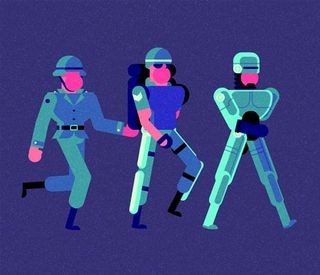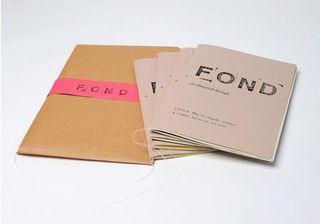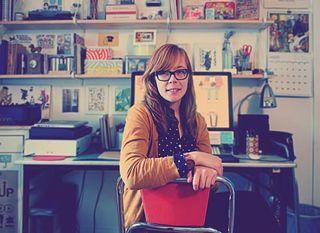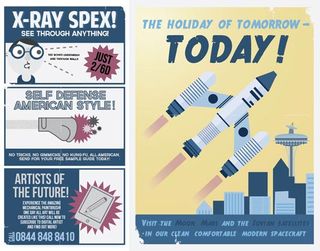The designer's guide to giving up your day job
Setting up on your own isn't as hard as it looks. We ask leading design freelancers to share their tips for success.
Odd work hours, long days, often times no real weekends - it isn't always easy to make a living doing what you love. Yet according to recent statistics 13.9 per cent of the population now work from home, with almost two-thirds of home-workers now self-employed.
Faced with another long commute on a dreary Monday morning, the idea of working for yourself can take on a magical allure. Daydreaming of a life where you can set your own routine, roll out of bed and straight to your desk in minutes and finally have the freedom you've always craved – but how does the reality measure up? Is it really that easy to quit your day job and go solo?
We talk to established freelancers and the ones just starting out to find out how they've managed to take the leap without losing friends, losing money or losing their mind. With their advice we hope you can do the same.
Make a graceful exit
Relationships are really important as people like people. Once you've made the decision to go freelance, take some time to let your contacts know.
If you're smart you'll give yourself plenty of time to plan your exit. Save enough money to keep you afloat for three months and (ideally) get a few commissions organised to avoid wasting time later.
Time is money when you're self employed and you'll quickly realise you need to be as efficient as possible with your routine. Once you've got the basics sorted, it's time to break the news to your employer: not an easy task, especially if you haven't been there very long.

"The founders of creative companies can be extremely passionate and driven, and may expect a similar emotional investment from their employees," says illustrator and animator Robin Davey who left his first full time job less than a year after taking the role. "But ultimately you aren't a stakeholder and it isn't disloyal to leave in pursuit of your own goals."
Get the Creative Bloq Newsletter
Daily design news, reviews, how-tos and more, as picked by the editors.
Tempting as it might be to tell your current boss where to stick it, in reality it's wise not to burn your bridges, for you never know when your paths may cross again. "If you're leaving a permanent position, do so on the best terms possible – even if you have legitimate grievances" continues Davey, who is known for his hypnotic loopy animation work.
"Creative communities tend to be small and close-knit – even in the bigger cities – and good word-of-mouth is invaluable to freelancers," continues Davey. "You don't want an embittered ex-boss to tarnish your reputation."
Wise up on your finances
For the majority of freelancers, cash-flow can be one of the hardest thing to manage. London-based designer Claire Hartley found that leaving her job quickly left her unprepared.
"It was a pretty spontaneous decision," she says. "I'd made up my mind and within six weeks I was gone.
In hindsight it was a bit risky," she reflects, adding that the stress of the first six months could have been avoided. "I hadn't considered how projects can run over – which in turn delays payments. Thankfully my overheads are pretty low so it's never been a disaster, but the transition could have been smoother."

Holding on to a part time job may not fit with your vision of freelance freedom, but in practice retaining the security of a regular income can take the pressure off.
The added flexibility it brings means you can also afford to be selective in the type of jobs you take on, though to be successful in the long term you have to be okay with the fact that you may not love every commission you get. "It isn't always easy to do what you love and have it be sustainable," says East Coast illustrator and designer Lydia Nicholls. "You have to really be mentally prepared for that level of dedication."
Be realistic
Naomi Dodds, who describes herself as a 'graphic designer, imagineer, and professional nerd' struggled to get work initially, and says it's important to be realistic. "When you're not established you often have to take on work that pays little to nothing," says the designer, confessing: "I got paid in glow-in-the-dark dinosaurs once."
Supporting her practice through a variety of part time jobs, Naomi had the breathing space to acquire clients gradually. "I'm slowly building a client base at my own speed and that works for me" she says, "Odd jobs, bar work – I've done allsorts. There's no shame in juggling other work. Pay the bills however you have to and pursue your passion in your spare time."

For Jake Ivill, finding work at the beginning was the hard part because of lack of reputation, but stuck at it. "I just kept working and accepted every job that came into my inbox.
"Also, because I started young, I sacrificed a lot of parties and relationships, but to me it wasn't seen as a sacrifice, because sitting in my room drawing was what I enjoyed most."
Setting up your work space
Once you're ready to go freelance dedicate some time to figuring out where you'd like to work.
Alternatives to working from home include hot-desking, renting a space or moving into a shared studio with other designers and illustrators, so think about your budget, existing client list and whether you will need space to conduct meetings or set-up photo shoots. Shared studios offer equipment and facilities that you wouldn't have access to at home – saving you money in the long run.
NanNa Hvass of multi-disciplinary arts and design studio HvassHannibal believes sharing a studio also helps build routine into your day. "Surrounding yourself with other people doing creative or freelance work creates momentum – you still feel you are going to work every morning – not working at home alone in your pyjamas all the time!"

Of course, for many of us, working from home is the cheaper and more sensible option, but once the novelty wears off you may find yourself missing the buzz of studio life, so it's important to build social activities into your working week to counter inevitable feelings of isolation.
"Once you're in it, you also have to make time to get out, interact with fellow illustrators and designers, and just breathe" says East Coast based designer and illustrator Lydia Nicholls, who experienced first hand the lonely side of freelance life when she first moved to Brooklyn.
"New York has a thriving art scene, but it's really easy to stay anonymous or outside the flow of things. There are literally millions of people in the city, yet it can be really hard to engage with them, especially when you're just starting out."

Graphic designer Jake Ivill has been working as a freelancer for the last five years, and has so far avoided sharing a studio to save costs, experimenting with various set-ups at home instead.
"I've had three different work spaces since being a freelancer," he says. "The worst was my bedroom which was the tiniest box room you've ever seen. I'd roll out of bed, straight to the desk, start work and then roll back into bed. I wouldn't recommend it – it nearly killed me."
Learning to say no
It's easy to say yes to everything when you don't know where your next month's rent is coming from, but sometimes it's just not worth it. Experiencing the obstacles of over-capacity can send any level headed creative into a minor panic, and for graphic designer Claire Hartley, it's something she is working hard to manage. "It isn't great for my clients, my projects or my wellbeing," she confesses.
Lydia Nicholls, whose clients include Chronicle Books, Bloomsberg Businessweek and Timbuktu agrees, advising designers to be honest with themselves."You need to know your limitations – how quickly you can work without compromising yourself and what deadlines are actually achievable."
Graphic designer Naomi Dodds believes that learning to say no will keep you sane. "Don't work for exposure unless you're really in love with the job and don't take on a huge workload if your heart's not in it."
Using your downtime
Outside the structured environment of a job or university, Robin Davey has found that motivation can ebb and flow, and recommends personal work as a way to stay mentally focused. "It's all too easy to lose creative momentum, so set projects for yourself and stick to them."

Establishing a routing early on will also help you ward off the temptation to procrastinate, though as Davey admits, a certain amount of 'time wasting' can actually help you be more productive in the long run. "Everybody does it, and creative work isn't best measured in hours, so pursue things as they interest you and allow yourself time to relax."
Whether you're striking out on your own with established clients, or a recent graduate looking to hit the ground running in the world of freelance, at some point you're going to hit a rough patch. Instead of waiting for the phone to ring, take advantage of the quiet periods, advises illustrator Robin Davey. "Freelancing can be feast-or-famine at times" says Davey, "but hitting a sustainable working rhythm, whether professional or personal, will help to carry you through rough patches."
NanNa Hvass agrees that it's vital to stay in touch with your own ideas to stay fulfilled and energised. "It's a very healthy thing to work on small projects in your spare time to keep your mind awake – whether you're a freelancer or working for studio." Davey concludes: "Freelancing can be isolating, exhausting, and financially fraught, but for me the trade-off is worth the freedom."
4 tips for freelance survival
- Always have a Plan B. If something can go wrong it will – whether that's a late payment or faulty hard drive. Be prepared.
- Be lucky. Just because you know someone who has coasted into freelancing amassing big clients doesn't mean the same will happen to you. A big part of success is luck and being in the right place at the right time. Don't beat yourself up about it.
- Buy a cafetiere – you'll be pulling all nighters, working weekends, and in all likelihood becoming nocturnal. Good coffee helps.
- Be prolific at what you do, stay focused and stay positive.
Words: Lisa Hassell

Thank you for reading 5 articles this month* Join now for unlimited access
Enjoy your first month for just £1 / $1 / €1
*Read 5 free articles per month without a subscription

Join now for unlimited access
Try first month for just £1 / $1 / €1
The Creative Bloq team is made up of a group of design fans, and has changed and evolved since Creative Bloq began back in 2012. The current website team consists of eight full-time members of staff: Editor Georgia Coggan, Deputy Editor Rosie Hilder, Ecommerce Editor Beren Neale, Senior News Editor Daniel Piper, Editor, Digital Art and 3D Ian Dean, Tech Reviews Editor Erlingur Einarsson and Ecommerce Writer Beth Nicholls and Staff Writer Natalie Fear, as well as a roster of freelancers from around the world. The 3D World and ImagineFX magazine teams also pitch in, ensuring that content from 3D World and ImagineFX is represented on Creative Bloq.
